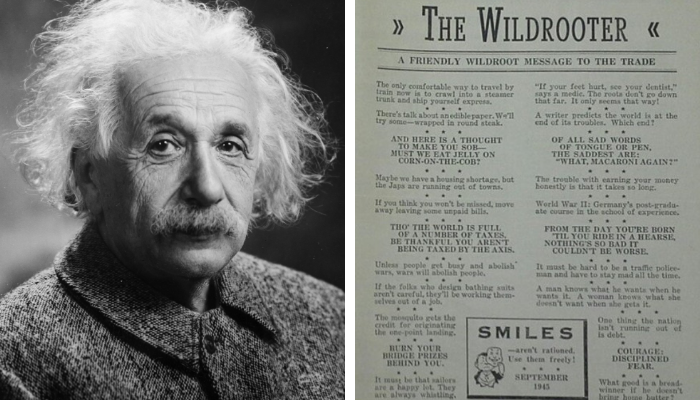A Look Into the Research Process for The ONE Thing
Here at The ONE Thing, all we do requires a lot of research. After reading a one-star review about a questionable quote from our book, we took a look at some of our past work, which led us to Princeton, New Jersey and the New York Public Library and all the way to Israel and back to Buffalo, New York. This blog post is about that journey.
As the research team who works with the authors who wrote The ONE Thing, we had to put in years of work up front in order for them to be able to write the book. We compiled thousands of scholarly articles, studies, papers and news articles, and read through a large variety of books to support the authors. (We have full, five inch binders of research that didn’t even make it into the final cut!) And since the day The ONE Thing hit bookshelves, we have put out dozens of resources that each necessitates their own cache of research.
Whether it’s a blog post, a free resource available for download, or anything in between – we take a deep dive into our material before we put it out for all to see. We want to help everyone stay curious about the world. So we do the dirty work to back up what we believe to be true and share it with you.
It’s a job that doesn’t end, even after we publish our work.
When Research Changes
Truth be told, there are moments when research isn’t as black and white as we may hope. Often the truth lies somewhere in the gray. For instance, researchers may conduct a new experiment that throws a new perspective over a previously held belief. This happened just this year with the famous Marshmallow Test and we updated the study to reflect those new findings in our latest printing of the book. Or a present-day event may impact things that we’ve previously written. Sometimes, we get access to new information or details that weren’t accessible at the time of publication. Whatever the case, our team of researchers are diligent and focused on getting the details right. But every now and then, something happens that gifts us the opportunity to correct something we got wrong.
Thanks to one of our Amazon reviewers, it recently came to our attention that one of the quotes in The ONE Thing we assigned to Albert Einstein may have been misattributed. We’d like to send a big thanks to that observant reader.
While some authors may cringe at a piece of negative feedback, we embrace it for two reasons. First, when readers bring their questions to us, they give us the opportunity to course correct. We can’t clear up a misunderstanding or identify a wrong if we don’t know it exists. Second, it gives us a chance to do what we love – nerd out on research we may not have seen before. This reader’s comment enabled us to do both. The journey our research took to validate this reader’s claim is just one day in the life of our research team – and one that gives our readers a fun glimpse behind the scenes at The ONE Thing. We thought we’d share our adventure with you as a way to show you how some of the lengths we go to while conducting our research.
What Did Einstein Say?
“If a cluttered desk is a sign of a cluttered mind, of what, then, is an empty desk a sign?”
– Albert Einstein?
At the time of publication back in 2013, we traced the authenticity of all the quotes in the book, including the one above, as far as we could. Since the book’s publication, this quote has seen some increased attention, which led many to question who the original source was. So much so, in the latest reprint of the book, we’ve noted this and added a “stay tuned” message of sorts about who the author actually may be.
But we felt like there was still room to do some more sleuthing to see if this quote attribution really was a dead-end. So, we set to work.
Because Einstein is such a prolific historical figure, there are several global facilities where experts study and store his works. We reached out to two such places. The first, The Institute for Advanced Study, in Princeton, New Jersey, names Einstein as one of its first professors, where he served until his death in 1955. This institution has helped us get to the bottom of other Einstein-related stories on more than one occasion. However, upon connecting with them about this particular quote in question, the answers remained fuzzy.
They, like us, scanned The Ultimate Quotable Einstein and didn’t find any mention of the quote, including in the “Probably not by Einstein” section. The archivists at this institute feel strongly that this quote book was a reliable source. They believe that because the quote isn’t in the book, it probably isn’t Einstein’s. As they told us, “It’s one of those instances when the absence of something is likely the best evidence available!” While they were unable to shed light on the origins of the quote, they were able to share a photograph of Einstein’s office desk at the time of his death. If this photo is any indication of what Einstein’s mind was like – it certainly looks cluttered! So while it’s not the quote we were looking for, it does substantiate that there may be something “truthy” about its attribution to Einstein. While he may not have said it, it could be the case that it is the way he felt – or at least something he might have agreed with.
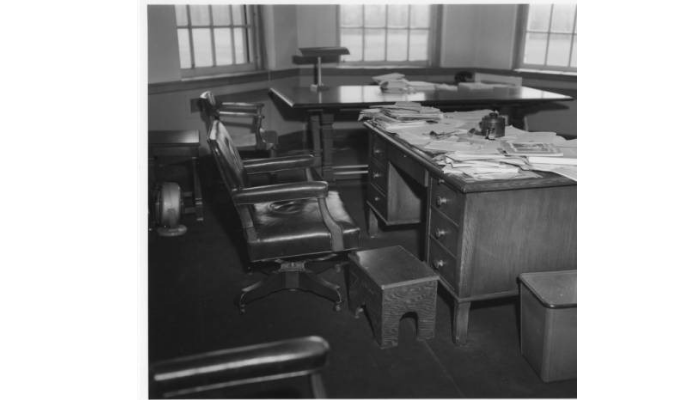
We turned to our second group of Einstein experts from the Albert Einstein Archives at the Hebrew University of Jerusalem. This is where Einstein willed all literary rights to his writings. Again, while they did not have the source of the quote to prove its authenticity, they couldn’t point to an alternate author. According to the archives, Einstein “was not the sort of person to retain every piece of paper that passed through his hands.” In fact, it wasn’t until he rose to fame in 1919 that he began to attempt to preserve his papers. And then there was the material he left at his summer house outside of Berlin. This material was purposely destroyed to prevent it from falling into Nazi hands.
What is interesting, however, is that while they don’t have proof of the quote, they too have proof that Albert Einstein had quite the cluttered desk. In the search for this quote, they pulled for us a letter housed at the Leo Baeck Institute in New York City. Einstein wrote this letter on June 9th 1937 to Kurt R. Grossman. And in it, he describes the piles of material on his desk. He writes in German:
“Wenn Sie die Berge auf meinem Schreibtisch sahen, wurden Sie sich uber nichts wundern.”
This translates roughly to:
“If you saw the mountains on my desk, you would not be surprised.”
Again, not substantiating. Just more truthiness.
Continuing the Trail
So if Einstein didn’t say it, then who did?
One of the best places to find information on misattributed quotes is the famous blog, Quote Investigator. Blogger Garson O’Toole is not just any ole’ webpage author. With a doctorate from Yale and a self-described love of “exploring quotations,” he clearly has the faculty to investigate complex questions. Even with a toolbox full of answered quotation queries he, maybe better than anyone, understands that some quotations leave more questions than answers. That may have been the case with the quote we included in our book.
When O’Toole explored the origins of this quote in an article on his blog, he found that the ascription to Albert Einstein was unsupported. Unfortunately, he was also unable to identify its original author.
We weren’t ready to give up the search, so we looked for a new avenue. Through O’Toole, we found a version of the quote in a copy of a 1955 edition of the Chicago Tribune. When we pulled the edition in question, we were disappointed to find that the quote was not highlighted in an article or captured in a printed interview. Instead, it was simply a pull-out quote (or in other words, the lone quote sitting in a text box) that referenced “The Wildrooter” as its author.
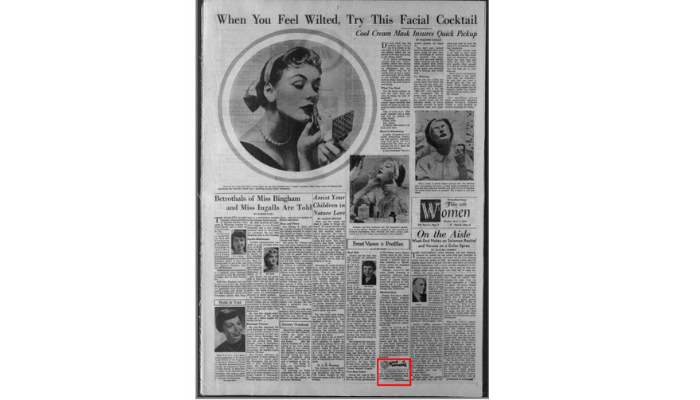
Well, who or what is The Wildrooter?
Like good researchers do, we took things a step further and picked up the trail where the Quote Investigator left off, and reached out to some local experts in upstate New York about the newsletter and company.
Based out of Buffalo, NY, when you think of The Wildroot Company, you should likely think of the outrageous hairstyle of yesteryear. Their best known product was Hair Tonic, a “cure-all” for bad hair that was mostly marketed toward men. However, women could benefit from it too. Early advertising claimed Wildroot Hair Tonic would “cure dandruff, prevent balding, and produce thick, lustrous hair.” Later, once Colgate-Palmolive purchased the company for $10.5 million in 1959, they used the tagline, “Grooms Clean as a Whistle, Quick as a Wink.”
While you’d be hard pressed to find a bottle of the stuff today, there was actually a time where the Wildroot brand was more recognizable than Vaseline. Business was booming and the “Wildroot Family” was quickly growing.
Between the 1940’s and 1960’s, the company produced a 3-page newsletter “…to help Wildrooters get to know each other.” And it was a pretty big deal. Not only did the Chicago Tribune run multiple quotes from The Wildrooter over the years, but more than sixty other papers across the entire country did as well. Lines from the newsletter like “America undoubtedly has the highest standard of living. Too bad we can’t afford it.” and “From the time an infant tries to get his toes in his mouth, life’s a continual struggle to make both ends meet.” were read by a national audience and attributed to “The Wildrooter” or “Wildrooter” every now and then.
In today’s world, a company would be lucky to have their employees read the emails they send them, let alone have its contents picked up and shared by a national audience.
As we learned more about The Wildrooter, the idea of this company newsletter being responsible for authoring the “Einsteinian” quote didn’t seem too far-fetched. So, to see if we could attach a name to the quote or find a new trail to follow, we set out to find a copy of the newsletter where it may have originally appeared.
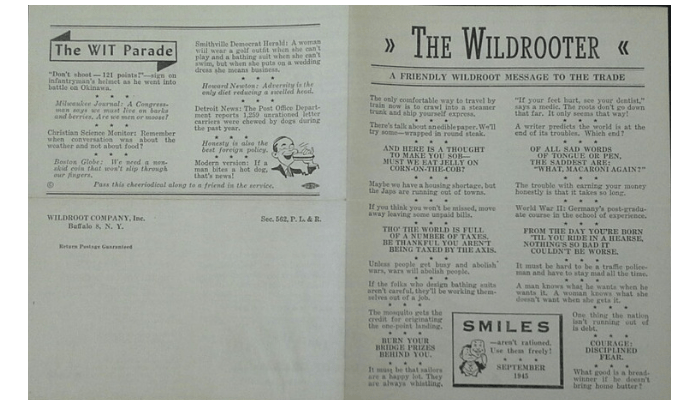
Finding a Needle in a Haystack
Our first stop was reaching out to the Western New York Foundation in hopes of finding out more about the company and getting our hands on their newsletters. It seemed like it might be a good lead considering this foundation also had roots in Buffalo and was formerly called the Wildroot Foundation. The two companies also had mutual stakeholders in common — the Western New York Foundation was formed in 1951 by both a legal advisor and a partial owner of the original Wildroot Company. Even crazier, it was formed with funds and stocks that primarily came from the former Wildroot Company. Unfortunately, our trail ran cold here.
They never even heard of the newsletter.
Next we reached out to the New York Public Library. The library came up nil in their search for The Wildrooter in their state-wide database, and even went so far as to tell us that they didn’t think any library would actually have it. As the archivist assisting advised, tracing a quote to a commercial newsletter is not great for reliability.
That was a little disheartening, but in case you couldn’t tell already, we’re pretty headstrong. So, instead of ending our search, we turned to booksellers, and found eight copies of The Wildrooter on eBay from a seller in Canada.
Unfortunately, they weren’t the issues we were looking for.
At this point, we were obsessing over all things Wildrooter, and our attention was brought to a news article on an effort to save the Wildroot Manufacturing Building in Buffalo, NY from demolition, where we found Mark Paradowski. A Wildroot enthusiast and historical preservationist, Mark reached out to his network of Wildroot family members to see what they could find.
It wasn’t long before he sent us a list of people who wrote for The Wildrooter, which he found in Wildroot Company “family albums” that were put together by the company. From the looks of it, the publication was produced on a volunteer basis by employees within the company. Accountants, secretaries, clerks, and manufacturing department heads all wrote columns, stories, updates, and at least prior to WWII, shared provoking or humorous thoughts that were published in The Wildrooter.
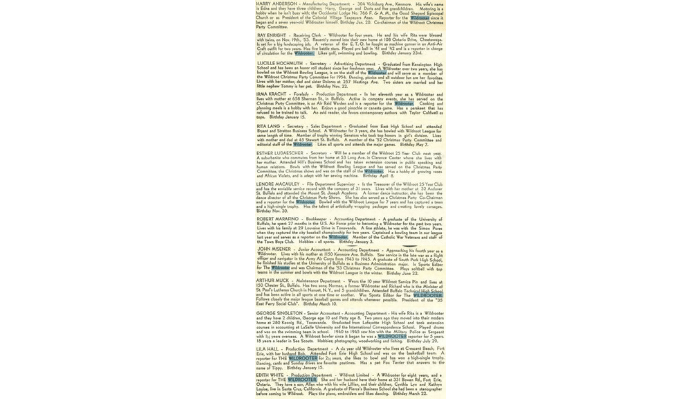
Mark also turned us over to the Buffalo History Museum. As it turns out, their research library has an archive of Wildrooter newsletters — which, to our knowledge, is the only such collection in existence. (Take that, New York Public Library!)
After a phone call, a couple of emails, and the tireless efforts of a library volunteer who combed through years of newsletters, we found something we didn’t expect.
The Buffalo Museum of History was able to confirm that The Wildrooter, at least prior to the end of WWII, produced a leaflet that resembles what you would think the Chicago Tribune was referencing in their quote. However, the research library was unable to find the quote we were looking for within their collection.
According to the information available to them, they said, “After the war, The Wildrooter became a lower-budget typewritten weekly newsletter focused on employee activities, such as weddings, safety tips, and recreational outings.”
Research Is the Process of Finding More Questions
So while they couldn’t confirm that The Wildrooter was responsible for the empty desk, empty mind quote, we at least have enough circumstantial evidence to believe that it’s at least a possibility. But their response, raised more questions.
If they stopped producing the newsletter that included all of those provoking thoughts and quotes before the war, then how and why were so many newspapers referencing after the war? Did the Wildroot Company produce two types of newsletters? One for mass market, which would be a continuation of their work during the war, and one for their employees? Or did the Chicago Tribune just have a stash of pre-war Wildrooter newsletters that they’d call on for inspiration from time to time?
Sometimes, at the end of the day, our research ends on a question instead of an answer.
In a conversation with Mark Paradowski, he said he wouldn’t be surprised if The Wildrooter was distributed to their national sales force or sent to barbershops and pharmacies.
It could be possible that there was some version of The Wildrooter that became a part of the company’s general advertising plan. According to him, the company was spending as much as $2 million a year on advertising throughout the 40’s (that’s more than $35 million in today’s dollars). And according to documents preserved through his Facebook page, given to him by the son of the man in charge the advertising account, that spend increased to a total as high as $3.1 million (the equivalent of more than $54 million today)—the highest spend in their product’s market.
On the back of the example newsletter the research library provided us, there might even be evidence to support this distribution theory. At the bottom left hand corner on the back of the page, you can see room for return postage. And in the inside of the leaflet, they even advertise their advertising spend. “BACKED BY $1,500,000 AD DRIVE IN ’45,” It reads at the bottom of the page.
It’s possible that after the war they continued distributing or writing these types of newsletters after the war, and that’s what the Chicago Tribune and other newspapers eventually got a hold of. However, at this point in time, we can’t prove, without a doubt, that’s what happened.
All we have is speculation.
As of now, our quest for finding a copy of the correct newsletter, and confirming The Wildrooter as the quote’s original author has reached a dead end. All we know is that, as far back as we can trace it, they currently hold the earliest attribution for the quote that we can find. And at this point, we turn our search for the lucky Wildrooter issue over to you, our readers. If you or your grandparents happen to have The Wildrooter issue that contains the quote we are trying to verify, reach out to us here at our contact page.
And That’s Just How it Goes Sometimes
As time goes by, the truth gets sketchy. Something is taken as fact and run with, and is the “truth” until it’s proved otherwise. It occurs time and again across every type of subject matter. Take, for instance, the 1950s example of Maxwell Maltz, who declared it only took 21 days to create a habit. This unsubstantiated statement was seen as a fact by many until the 2000s, when the researchers overturned his beliefs with their own research findings.
Sometimes research provides no conclusive answers. We followed bunny trail after bunny trail on the hunt to determine the validity of this quote, but still came up empty. Did Einstein say these words? Probably not, but we don’t know for sure. And because we don’t know for sure, we now need to question our original conclusion. What we do know, however, is this: he lived this quote behaviorally.
As we say in The ONE Thing, “A not-so-funny thing happens along the way to extraordinary results. Untidiness. Unrest. Disarray. Disorder. When we tirelessly work our time block, clutter automatically takes up residence around us.”
In other words, when we are working on the things that matter most, other things tend to fall by the wayside. Chaos and messiness can take hold. Despite the fact that we do not have any formal documents with the quote, we absolutely do have documentation that this world-renowned genius had quite the cluttered desk while he was discovering theories that would forever change our lives.
Our ONE Thing is making The ONE Thing the best it can be for our readers, whether it be through our writing, our programs, or our research. And to that end, we love when our readers can help us be our best. If you like what you’ve learned from us (or even if you don’t!) and haven’t left a review for us on Amazon yet, please consider doing so! We do go through these reviews and can learn something from each one! After all – see how much we’ve gotten out of a single one-star review?
Now, onto the next research question….once we can get through all the clutter on our desks!

